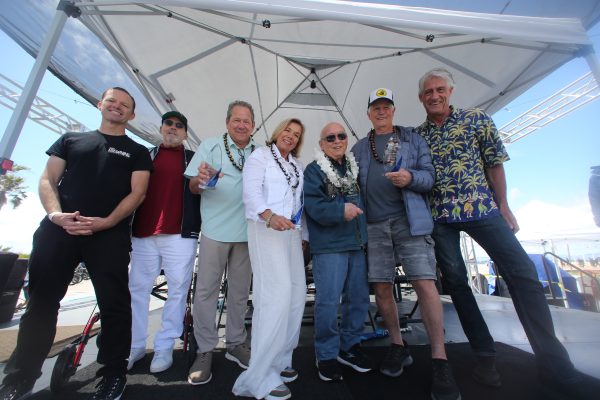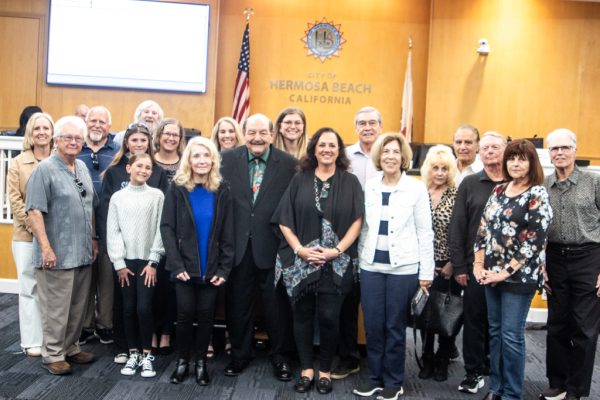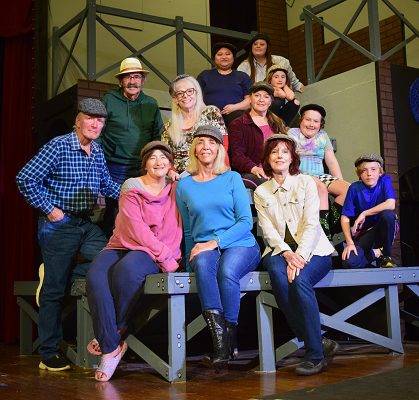What does it take to remove 175 tons of sometimes surging dead sardines from a harbor?
The city learned the answer to this question the hard way last week, and on Tuesday night the officials who led the effort gave a joint report to the City Council detailing how exactly this unusual task was accomplished.
Director of Public Works Mike Witzansky praised his staff for “six long days, six back-breaking days” and listed the array of equipment used, including skiffs, air compressors, fireboat hoses, forklifts, front loaders, about 200 nets, 125 buckets, 35 roll-off garbage bins, 18 wheelbarrows, and six vacuum sewer cleaning trucks from Redondo, Hawthorne, Gardena, Manhattan Beach, and Huntington Beach.
But Witzansky said the bulk of the cleanup ultimately came down to one simple method.
“For the most part, the mantra was hands with nets – the biggest deployment method, and the most effective deployment method from start to finish,” Witzansky said.
Toward that end, the city was able to enlist 700 volunteers, including nearly 1,700 hours from members of the Citizens Emergency Response Team.
Police Chief Joe Leonardi praised how well everyone worked together, and noted that city employees meshed well with volunteers.
“You should be very proud,” Leonardi said. “They accepted volunteers as co-workers and asked them to come in with open arms, which often in government doesn’t happen. We often want to do it all ourselves, but we couldn’t have done it without the volunteers.”
Fire Chief Dan Madrigal said the effort was made effective by the emergency response plan the city has in place, which included the quick establishment of an around-the-clock command center.
“It is a true testament this city is prepared for any type of disaster emergency, large scale or small,” Madrigal said. “What started out as something that was an oddity turned into a major conflagration in many ways, shapes and forms.”
Harbor, Business, and Transit Director Pete Carmichael – who had been on the job less than two weeks when the fish kill occurred – said he and his staff called every harbor and marina up and down the coast to learn how other cities had coped with such incidents. He said the two methods most often used, dive teams with vacuum hoses and volunteers with scoops, were put into play simultaneously here.
“It was a pretty remarkable sight but I think it worked pretty well,” Carmichael said.
The challenge of the cleanup was increased after the earthquake in Japan lead to Tsunami warnings in the harbor and four to eight foot surges on Friday morning. City Manager Bill Workman noted that Mayor Mike Gin put in an overnight shift as “intelligence” coordinator tracking tsunami reports.
“We want to make sure everyone knows the leadership of the mayor…and more than just policy leadership, he was behind the keyboard,” Workman said.
Carmichael also praised U.S.C. marine biologist Dave Carons for helping the city understand immediately that at least as many fish were on the bottom of the marina as on the surface. Carmichael said 75 tons were taken from the bottom of the marina.
Carons said one of the initial mysteries of the fish die-off had been solved this week. The fish showed signs of demoic acid poisoning, a naturally occurring process that happens when fish come into contact with certain algae blooms that produce toxins. The harbor itself contained no such algae, Carons said, but tests off the Peninsula coast discovered toxin-producing blooms. Carons surmised that the fish – who were then neurologically impaired by the toxin – rushed the harbor. Their mass death resulted from the lack of dissolved oxygen due to the large numbers of sardines in one place.
“They were the cause of their own demise,” Carons said.
Athens Services, the city’s new trash hauler, plans to bring the fish back in coming months as compost material for gardens.
Workman said that the final cost of the cleanup was roughly $300,000. He said the city hopes to receive some federal or possibly state disaster relief funds to help pay the cost. He also noted that a state fish and game official praised the city’s response.
“He was effusive in his praise,” Workman said. “He said this is the best response he’d ever seen in 28 years working for Fish and Game.” ER










